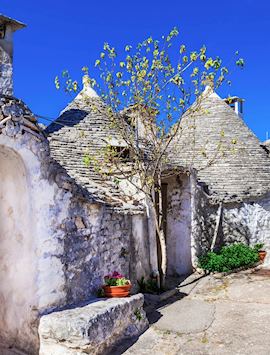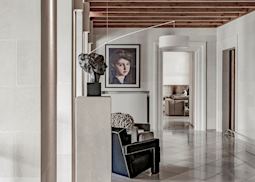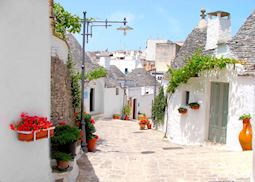Jump to:
Sometimes referred to as 'the Florence of the South', Lecce is best known for its exuberant Baroque architecture. It's far quieter and less crowded than its namesake, however. A relaxed university city with a glut of flamboyant buildings, its panache owes as much to the properties of the local limestone as to 17th-century fashions.
The soft local stone is easy to carve yet hardens with time and was exploited by the Romans and put to flowery use from the 15th century onward. At the time, Lecce was one of the most important cities in southern Italy, and its ornate buildings are at the heart of its warm character.
Small enough to explore on foot and quiet because of its restrictive traffic regulations, Lecce is a great town for walking or cycling. Take a bike tour to explore its quieter corners or explore on foot during the afternoon riposo (rest) when the streets are almost deserted and you can meander down lanes where plants tumble over balconies and handsome old buildings wrap around every corner.
The main streets are lined with shops and restaurants and lead to grand plazas where Baroque churches dominate every view. At the end of the 16th century, Lecce's importance piqued the interest of Italy's religious orders. They flocked here, hoping to win the souls of the city's wealthy and faithful.
Italy specialist JuliaI think Lecce is one of the most beautiful cities in Puglia thanks to its blend of ancient Roman and Florentine Renaissance architecture. It’s wonderful to stroll through Lecce’s winding streets to find a new cafĂ© or ancient ruins.
Things to see and do in Lecce
Basilica di Santa Croce
Today, you’ll find extravagant churches all over the city, built in a style so florid it merited its own name, Barocco Leccese (Lecce Baroque). The most remarkable of all is the Basilica di Santa Croce, which has a richly ornate façade with a large rose window, grotesque figures and an extraordinarily detailed entablature.
It took two centuries to complete the building, whose feast of sculpture features everything from saints and scrolls to livestock and cherubs. The interior is a little more sedate yet still manages to fit in 17 altars, Baroque artwork and a selection of family tombs.
Piazza del Duomo
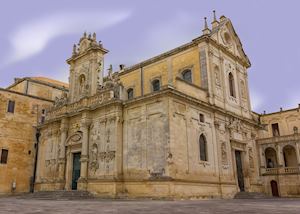 Surrounded on three sides by stately, honey-toned buildings, the enormous Piazza del Duomo is a Baroque masterpiece with the city's cathedral as its focal point. The Duomo di Lecce was built in the 12th century, but substantially overhauled in Baroque style by local architect and sculptor Giuseppe Zimbalo in the mid 17th century.
Surrounded on three sides by stately, honey-toned buildings, the enormous Piazza del Duomo is a Baroque masterpiece with the city's cathedral as its focal point. The Duomo di Lecce was built in the 12th century, but substantially overhauled in Baroque style by local architect and sculptor Giuseppe Zimbalo in the mid 17th century.
The massive portal is flanked by towering columns and mounted by a high balustrade and decorative arch. Inside, you’ll see an ornate coffered ceiling, 12 side chapels and a collection of Baroque paintings.
The square is dominated by the cathedral's bell tower, which has five tapering levels surmounted by a majolica dome. Next to the cathedral is the Episcopal Palace and, on the western side of the square, the Seminary.
Porta Napoli
Lecce's main city gate, Porta Napoli was erected in 1548. The triumphal arch was built in anticipation of a state visit from Holy Roman Emperor Charles V, and the pediment is decorated with the Spanish coat of arms flanked by a set of weapons.
At the opposite end of the Piazzetta Arco di Trionfo is a 19th-century obelisk decorated with mythological creatures, which was a homage to Ferdinand I, the King of the Two Sicilies.
Roman amphitheater
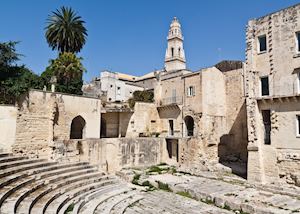 Lecce's main square, Piazza Sant’Oronzo, is part swallowed by a sunken 2nd-century Roman amphitheater, which sits below the modern level of the city. With seating for 15,000, it once marked the end of the ancient Via Appia (Appian Way), which connected Rome with the south of Italy.
Lecce's main square, Piazza Sant’Oronzo, is part swallowed by a sunken 2nd-century Roman amphitheater, which sits below the modern level of the city. With seating for 15,000, it once marked the end of the ancient Via Appia (Appian Way), which connected Rome with the south of Italy.
Only one of the two tiers of seating remain, along with fragments of friezes, bas-reliefs and Latin inscriptions. Guided tours are available and help illuminate the history and significance of the site.
A couple of blocks away are the remains of a Roman theater, now a small museum exhibiting well-preserved frescoes and mosaics from other local sites.
Castle of Charles V
Charles V decided to refortify Lecce in the 16th century to avert an invasion by the Ottomans. A new castle, Puglia's largest, was built around a 12th-century Norman tower, and over the years it has been a prison, military barracks and court.
Today, it houses the city's cultural department. You can wander around inside, attend a concert or visit the papier-mâché museum. Lecce is known for its fine papier-mâché artisanship, and the museum’s exhibits date from the 18th century to the present day.
Best time to visit Lecce
Lecce can be visited year round but the best weather is between late May and early October with peak season in July and August. May sees the private courtyards in the old town open to the public, while in late August there’s a three-day celebration of the town’s patron saints. The winter sees fewer visitors and cooler temperatures which makes it a good time for exploring.
who's been there
-
617-223-4521617-223-4395
- Make an inquiry
Suggested itinerary featuring Lecce
This sample itinerary will give you an idea of what is possible when you travel in Lecce, and showcases routes we know work particularly well. Treat this as inspiration, because your trip will be created uniquely by one of our specialists.
Places near Lecce
- Otranto 22 miles away
- Ostuni 41 miles away
- Fasano 55 miles away
- Alberobello 58 miles away
- Puglia 65 miles away
- Matera 86 miles away
- The Amalfi Coast 189 miles away
- Pompeii 195 miles away
- Sorrento 201 miles away
- Herculaneum 204 miles away
- Capri 209 miles away
- Naples 209 miles away
- Ischia 224 miles away
- Taormina 233 miles away
- Mount Etna 249 miles away
- Sicily 275 miles away
- Syracuse 276 miles away
- Villa Romana del Casale 293 miles away
Photos of Lecce
Our expert guides to exploring Lecce
Written by our specialists from their own experiences of visiting Lecce, these guides will help you make the most of your time there. We share both our practical recommendations and the best ways to appreciate Lecce at its best.
-
A guide to the regions of Italy ![Local fishing boats, Lake Como]()
A guide to the regions of Italy
A guide to the regions of Italy
A tour of a private palazzo, or a cooking class with a Sorrento grandmother? We highlight the major sights and unearth lesser-known attractions for some of our best-loved Italian regions, spotlighting tours that really explore their character.
Read this guide
Accommodation choices for Lecce
We've selected a range of accommodation options for when you visit Lecce. Our choices usually come recommended for their character, facilities and service or location. Our specialists always aim to suggest properties that match your preferences.
-
![Risorgimento Resort, Lecce]()
Risorgimento Resort
Lecce -
![Hall, La Fiermontina]() Responsible ChoiceWe've hand-selected a range of tours and stays across the world that go above and beyond to be a force for good by supporting local businesses, educating staff, challenging local norms, or promoting conservation and biodiversity efforts. Your Responsible Choice helps increase the positive impact of your trip.
Responsible ChoiceWe've hand-selected a range of tours and stays across the world that go above and beyond to be a force for good by supporting local businesses, educating staff, challenging local norms, or promoting conservation and biodiversity efforts. Your Responsible Choice helps increase the positive impact of your trip.La Fiermontina
Lecce -
![Patria Palace Hotel, Lecce]()
Patria Palace Hotel
Lecce
Ideas for experiencing Lecce
Our specialists seek out authentic ways to get to know the places that could feature in your trip. These activities reflect some of the experiences they've most enjoyed while visiting Lecce, and which use the best local guides.
-
Puglian villages tour (Alberobello, Cisternino and Martina Franca) ![Alberobello, Puglia]()
Puglian villages tour (Alberobello, Cisternino and Martina Franca)
Puglian villages tour (Alberobello, Cisternino and Martina Franca)
You can visit Puglia's most characterful villages on a full-day private guided tour of their historic streets, shady squares and medieval churches. See Alberobello's conical trulli, the whitewashed hilltop town of Cisternino, and the Baroque and Rococo buildings of Martina Franca.
View details


